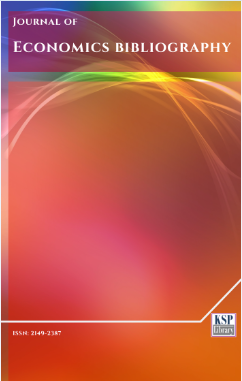Do financial inclusion drive boom-bust cycles in Africa?
Abstract
Abstract. The paper probes the roles of Financial Inclusion and human capital financing as catalysts for economic growth in Africa during the boom and burst periods. It adopts a battery of estimators like the Pooled OLS, Fixed Effect, Generalized Method of Moment and the Pairwise Granger Causality Tests for a panel of 57 African countries over the period stemming 2004-2015. The results show that financial inclusion has led to increased economic growth and stability in African while the impact of human capital still needs more commitments. The emanating policy antidotes are that there is urgent need for the CBs in Africa to intensify more efforts in banking the unbanked population and also, government should raise the percentage of budget allocation on education in other to improve on the level of human capital and achieve the very much needed sustained development in Africa.
Keywords. Financial education, Financial inclusion, Financial literacy, Africa.
JEL. D14, D18, G21, I28.
Keywords
References
Aghion, P., & Bolton, P. (1997). A theory of trickle down growth and development, Review of Economics Studies, 64(2), 151-74. doi. 10.2307/2971707
Archana, H.N. (2013). Financial inclusion- role of institutions innovative, Journal of Business and Management, 2(4), 44-48.
Arora, R.U. (2012). Financial inclusion and human capital in developing Asia: The Australian connection. Journal of Third World Quarterly. 33(1), 177-197. doi. 10.1080/01436597.2012.627256
Arunachalm, R.S. (2008) Scoping paper on financial inclusion. The United Nations Developing Programme, on Lasting Solutions to development Challenges. pp. 1-50.
Atkinson, A.B. (2012). Can we reduce income inequality in OECD countries? Empirica, 42(2), 211-223. doi. 10.1007/s10663-015-9288-0
Bernanke, B. (2006). Financial literacy, testiminy before the Committee on Banking, Housing and Urban Affairs of the United State Senate. [Retrieved from].
Birdsall, N. (2007). Reflection on the Macro-Foundation of the Middle Class in Developing World. Center for Global Development Working Paper, No.130. [Retrieved from].
Broadbent, B. (2016). Central Bank and Digital Currencies, Bank of England Working Paper Series. No.725. [Retrieved from].
Camara, N., & Tuesta, D. (2014) Measuring financial inclusion: A multidimensional index. BBVA Research Working Paper, No.14/26. [Retrieved from].
Carbos., Gardener, P.M., & Molyneux, P. (2005). Financial Exclusion, Palgrave MacMillan.
Demirguc-Kunt, A., & Klapper, L. (2012) Measuring Financial Inclusion: The Global Financial Inclusion Index, Washington, D.C. World Bank. [Retrieved from].
Demirguc-Kunt, A., & Levine, R. (2008) Finance financial sector policies, and long run growth. M. Spencer Growth Commission Background Paper, No11. [Retrieved from].
Demirguc-Kunt, A., & Klapper, L., Singer, B. (2017). Financial inclusion and inclusive growth: A review of recent empirical evidence. Policy Research Working Paper, No.8040. [Retrieved from].
Dobrowski, M. (2017). Potential of financial innovation on financial services and monetary policy. Center for Social and Economic Research, No.488. [Retrieved from].
International Financial Corporation, (2017). Digital Financial Services: Challenges and Opportunities for Emerging Market Banks, EmCompass.
Lenka, S., & Bairwa, K.A. (2016). Does financial inclusion affect monetary policy in SAAR countries? Cogent Economic and Finance, 4, 1127011. doi. 10.1080/23322039.2015.1127011.
Evans, D., Green, C., & Murinde, V. (2002). Human capital and financial development in economic growth: New evidence using the translog production function. International Journal of Finance and Economic Growth, 7(2), 123-140. doi. 10.1002/ijfe.182
Grohman, A., & Lukas, M. (2017). Financial literacy promotes financial inclusion in both poor and rich countries. World Bank Publication.
Hermannssona, K., Lisenkova, K., Lecca, P., McGregor, P., & Swales, J.K. (2017). The external benefit of higher education, Journal of Regional Studies. 51(7), 1077-1088. doi. 10.1080/00343404.2016.1172062
Izushi, H., & Huggins, R. (2004) Empirical analysis of human capital development and economic growth in European Region. Third Report on Vocational Training Research in Europe, Series, No.54. [Retrieved from].
Mankiw, N., Romer, D., & Weil, D. (1992). A contribution to empiric on economic growth, Quarterly Journal of Economics, 107(2), 407-437. doi. 10.2307/2118477
Mckinsey & Co (2015) Digital finance for all: Powering inclusive growth in emerging economie, McKiney Global Institute. [Retrieved from].
Mesagan, E.P., & Shobande, O.A. (2017). The case of Nigerian economy. Journal of Economics and Business Research, 22(2), 171-186.
Mainelli, M., & Mill, S. (2016). Financial Innovation and Sustainable Development. Business & Sustainable Development Commission, London EC2R 7HG, United Kingdom.
OECD, (2013). Advancing National Strategies for Financial Education. Joint Publication by Russia’s G20 Presidency and The OECD.
OECD, (2016). Survey on Measuring Financial Literacy and Financial Inclusion.
OECD, (2017). Enhancing the Contributions of SMEs in a Global and Digitalized Economy. Meeting of the OECD Council at Minister level report.
Oke, D.M., & Shobande, O.A. (2016). Predictor of financial inclusion and implication for money demand in Nigeria. Journal of Economic Studies, .
Raskin, M., & Yermack, D. (2016). Digital currencies, decentralized ledgers, and future of central banking, NBER Working Paper Series, No.22238. doi. 10.3386/w22238
Sherifffdeen, A.T., & Osoba, M.A. (2017). Human capital variables and economic growth: An interactive effect, EuroEconomica, 36(1), 131-143.
Shobande, O.A., Odeleye, A.T., & Olunkwa, N.C. (2014) Human capital investment and economic development: The Nigerian experience. World Journal of Social Science, 1(2), 107-115. doi. 10.5430/wjss.v1n2p107
Shobande, O.A. (2017) Stock market development, deposit money bank and long term growth in Nigeria. Journal of Economics and Allied Research, 2(1), 15-25.
Shobande, O.A., & Etukomeni, C.C. (2017). Financing development for sectorial growth: A cointegration approach. Iranian Economic Review, 15-25.
Tufano, P. (2003) Financial innovation, In G.M. Constatinidis, M. Harris, & R.M. Stulz (Eds), Handbook of Economics of Finance, Vol.1, Part.1.
World Bank, (2008). Finance for all? (Policies Pitfall in Expanding Access) World Bank Policy Research Report. Washington, D.C, World Bank. [Retrieved from].
Wyman, O (2017) Accelerating Financial Inclusion in South-East Asia with Digital Finance. Asian Development Bank Working Paper Series. [Retrieved from].
DOI: http://dx.doi.org/10.1453/jeb.v5i3.1718
Refbacks
- There are currently no refbacks.
.......................................................................................................................................................................................................................................................................................................................................
Journal of Economics Bibliography - J. Econ. Bib. - JEB - www.kspjournals.org
ISSN: 2149-2387.
Editor: [email protected] Secretarial: [email protected] Istanbul - Turkey.
Copyright © KSP Library

